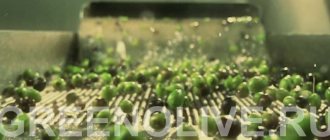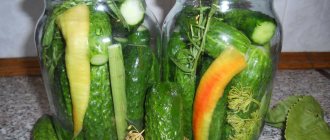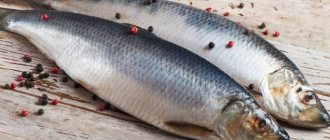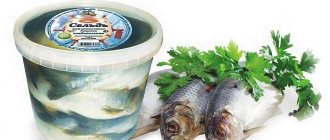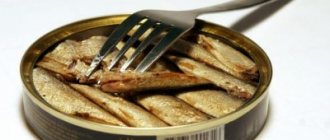What you need to know before salting herring
- For pickling at home, chilled Atlantic or Pacific herring is best suited.
- We have a separate infographic on how to choose fish. Study it carefully and under no circumstances buy herring without a head or fins. They are often cut off to hide the spoilage of the product. It is better to take a whole fish and, if necessary, cut it yourself.
- Frozen fish should not be defrosted in the microwave or placed in warm water. Defrosting should be natural: place the herring on a plate and keep in the refrigerator until thawed.
- Do not use iodized or too fine salt for salting herring. The first distorts the taste, and the second is easy to overdo.
Classic recipe in the oven
Canned herring, prepared at home with a basic set of ingredients, can be consumed as an independent dish, and can also be used to prepare salads and soups.
What ingredients will you need?
For canning herring we use:
- high-quality vegetable oil (preferably from sunflower seeds), odorless – 180-250 ml;
- defrosted herring (choose medium-sized fish) – 2 pcs.;
- black pepper (choose in the form of peas) – 8 peas;
- salt (select for canning) – 20 g;
- spices (you can use dry clove buds, mustard seeds or dry dill seeds) – 7-10 g.
The type of spices can be chosen according to taste preferences.
Step-by-step cooking process
The stages of canning herring are as follows:
- First you need to wash the herring carcasses.
- Next, the fish must be cleaned of scales. It is recommended to carry out manipulations with a specialized knife so that the scales do not scatter too much around the room.
- Cut off the head of the cleaned carcass along with the gills, tail and fins.
- Carefully open the belly of the herring and remove all the insides. When removing giblets, it is important not to damage the integrity of the gallbladder, otherwise it will be impossible to wash out the bitterness from the carcass.
- Then you need to remove large bones from the fillet. The spine and small bones can be left. They soften during cooking.
- After completing the procedures, it is recommended to rinse the fish thoroughly and remove excess liquid with a paper towel (a cloth towel is not recommended, since it is then difficult to wash it off from the fishy smell).
- Cut each fish carcass into pieces approximately 2.5-3 cm wide.
- Next, it is advised to sterilize the container. For a given amount of ingredients, it is enough to use 2 jars with a capacity of 0.5 liters. You can sterilize using the following methods:
- Place the jars upside down on the oven rack. After this, the oven must be turned on at 130 degrees. Keep the container in the oven for at least 20 minutes. The door of the oven compartment must not be opened during sterilization. Also, you can’t put jars in an already preheated oven, as they will immediately crack due to the temperature difference;
- pour distilled water into the multicooker (approximately 0.7-1 l). Place jar lids in water. Then you need to put a grate in the device for steaming dishes. Place the jars on the wire rack. Turn on the device in steaming mode. The recommended holding time for cans is at least 10 minutes;
- put the jars in the microwave. Set the device to maximum power. Turn on the microwave for approximately 40-50 seconds. To sterilize the lids, they must be placed in a deep plate with water. Set the processing time to 5 minutes;
- Pour water (about 1 liter) into a wide saucepan. Place the lids in the water and place the jars upside down. Place the pan on a medium heat burner. Keep the pan on the fire for at least 10 minutes (time must be counted from the moment the water boils).
- Wait for the jars to cool slightly.
- While the jars are cooling, it is advisable to mix the salt with the selected spices and peppercorns.
- Next, you need to put a layer of fish on the bottom of the jar and sprinkle it with a mixture of point 10. Then again a layer of fish and spices. Repeat manipulations until all ingredients are used. In this case, the last layer needs to be fish.
- After this, vegetable oil should be poured into the jars. It should completely cover the contents.
- Cover the jars with lids (no need to tighten them) and place them in a cold oven.
- Set the oven temperature to 180 degrees and wait until bubbles appear in the oil.
- Then the oven temperature should be reduced to 100 degrees. You need to simmer the preserved food at this temperature for about 5 hours. In this case, you need to check that there are always bubbles in the oil. If the bubbles disappear (this means that the required temperature for preserving fish is not maintained), then you need to increase the temperature in the oven by 3-5 degrees.
- When simmering canned food, it is not recommended to open the oven door.
- After 5 hours, the cans of canned food should be removed from the oven, immediately rolled up and turned upside down. Cover the workpiece with a blanket.
After 24 hours (when the canned food has cooled), the fish can be served or stored in a cool place.
The article describes recipes for preparing canned herring at home.
If you want canned herring to have a smoked taste, then you need to put 2-3 prunes in the jar when canning. You can also prepare the preparation by including in the set of products natural tomato paste in the amount of 100 ml and 5 ml of vinegar essence (70%).
How to pickle herring in brine with spices
Photo: PrettyIrina / Depositphotos This is a classic way. Ideal for pickling whole herring.
Ingredients
- 2 herrings;
- 1 liter of water;
- 2 tablespoons salt;
- 1 tablespoon sugar;
- 3–4 bay leaves;
- black peppercorns, allspice and cloves - to taste.
Preparation
Remove the gills from the fish: they can add bitterness to the marinade. Gutting and cleaning the herring is not necessary. You can simply rinse and dry with paper towels.
Boil the water. Add salt, sugar and spices. Let simmer for 3-4 minutes. Remove from heat and let cool.
Take a plastic container or enamel pan with a lid. Place the herring there and fill it with cooled brine. If the brine does not completely cover the fish, use pressure. Otherwise, you will have to turn the herring over from time to time.
Let stand for 3 hours at room temperature, then put in the refrigerator. After 48 hours you can try.
Try it





